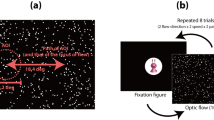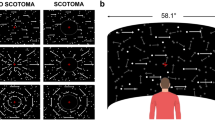Abstract
Sensitivity to rotational motion, one of the fundamental components of optic flow, was tested in infants aged 2 and 3 months. The infants in both groups showed significant sensitivity to rotational motion only in the high-speed condition (10.62°/s). There was no significant increase in motion sensitivity between 2 and 3 months of age, indicating that there is not a significant developmental change during this period. A comparison of our results with previous findings that showed a significant increase in radial motion sensitivity between 2 and 3 months suggests that different motion sensitivities have different developmental time courses.



Similar content being viewed by others
References
Arterberry ME, Yonas A (2000) Perception of three-dimensional shape specified by optic flow by 8-week-old infants. Percept Psychophys 62:550–556
Atkinson J (1979) Development of optokinetic nystagmus in the human infant and monkey infant: an analogue to development in kittens. In: Freeman RD (ed) Developmental neurobiology of vision. NATO Advanced Study Institute Series. Plenum Press, NY
Atkinson J, Braddick OJ (1981) Development of optokinetic nystagmus in infants: an indicator of cortical binocularity? In: Fisher DF, Monty RA, Senders JW (eds) Eye movements: cognition and visual perception. Lawrence Erlbaum Associates, Hillsdale, NJ, pp 53–64
Ball W, Tronick E (1971) Infant responses to impending collision: optical and real. Science 171:818–820
Ball WA, Ballot R, Dibble A (1983) Stimulus dimensionality and infants’ perceived movement in depth. J Genet Psychol 143:193–200
Banton T, Bertenthal BI (1997) Multiple developmental pathways for motion processing. Optom Vis Sci 74:751–760
Bertenthal BI, Bradbury A (1992) Infants’ detection of shearing motion in random-dot display. Dev Psychol 28:1056–1066
Bower TGR, Broughton JM, Moore MK (1970) Infant response to approaching objects: an indicator of response to distal variables. Percept Psychophys 9:193–196
Braddick O, Atkinson J, Wattam-Bell J (2003) Normal and anomalous development of visual motion processing: motion coherence and ‘dorsal-stream vulnerability’. Neuropsychologia 41:1769–1784
Clifford CW, Beardsley SA, Vaina LM (1999) The perception and discrimination of speed in complex motion. Vis Res 39:2213–2227
Duffy CJ, Wurtz RH (1991) Sensitivity of MST neurons to optic flow stimuli I. A continuum of response selectivity to large-field stimuli. J Neurophysiol 65:1329–1345
Geesaman BJ, Qian N (1996) A novel speed illusion involving expansion and rotation patterns. Vis Res 36:3281–3292
Gilmore RO, Rettke HR (2003) Four-month-olds’ discrimination of optic flow patterns depicting different directions of observer motion. Infancy 4:177–200
Gilmore RO, Baker TJ, Grobman KH (2004) Stability in infants’ discrimination of optic flow. Dev Psychol 40:259–270
Graziano MS, Andersen RA, Snowden RJ (1994) Tuning of MST neurons to spiral motions. J Neurosci 14:54–67
Kanazawa S, Shirai N, Otsuka Y, Yamaguchi MK (2007) Perception of motion transparency in 5-month-old infants. Perception 36:145–156
Kobayashi Y, Yoshino A, Kawamoto M, Takahashi Y, Nomura S (2004) Perception of apparent motion in depth: a high-density electrical mapping study in humans. Neurosci Lett 354:115–118
Koenderink JJ (1986) Optic flow. Vis Res 26:161–179
Koyama S, Sasaki Y, Andersen GJ, Tootell RB, Matsuura M, Watanabe T (2005) Separate processing of different global-motion structures in visual cortex is revealed by FMRI. Curr Biol 15:2027–2032
Mason AJ, Braddick OJ, Wattam-Bell J (2003) Motion coherence thresholds in infants—different tasks identify at least two distinct motion systems. Vis Res 43:1149–1157
Morrone MC, Tosetti M, Montanaro D, Fiorentini A, Cioni G, Burr DC (2000) A cortical area that responds to specifically to optic flow, revealed by fMRI. Nat Neurosci 3:1322–1328
Nanez JE Sr (1988) Perception of impending collision in 3-to 6-week-old human infants. Infant Behav Dev 11:447–463
Nanez JE Sr, Yonas A (1994) Effects of luminance and texture motion on infant defensive reactions to optical collision. Infant Behav Dev 17:165–174
Price CM, Gilden DL (2000) Representations of motion and direction. J Exp Psychol Hum Percept Perform 26:18–30
Ptito M, Kupers R, Faubert J, Gjedde A (2001) Cortical representation of inward and outward radial motion in man. Neuroimage 14:1409–1415
Shirai N, Kanazawa S, Yamaguchi MK (2004a) Asymmetry for the perception of expansion/contraction in infancy. Infant Behavior & Development 27:315–322
Shirai N, Kanazawa S, Yamaguchi MK (2004b) Sensitivity to linear-speed-gradient of radial expansion flow in infancy. Vis Res 44:3111–3118
Shirai N, Kanazawa S, Yamaguchi MK (2006) Anisotropic motion coherence sensitivities to expansion/contraction motion in early infancy. Infant Behav Dev 29:204–209
Shirai N, Kanazawa S, Yamaguchi MK (2008) Early development of sensitivity to radial motion at different speeds. Exp Brain Res 185:461–467
Tanaka K, Saito H (1989) Analysis of motion of the visual field by direction, expansion/contraction, and rotation cells clustered in the dorsal part of the medial superior temporal area of the macaque monkey. J Neurophysiol 62:626–641
Wattam-Bell J (1991) Development of motion-specific cortical responses in infancy. Vis Res 31:287–297
Wattam-Bell J (1996) Visual motion processing in one-month-old infants: preferential looking experiments. Vis Res 36:1679–1685
Wunderlich G, Marshall JC, Amunts K, Weiss PH, Mohlberg H, Zafiris O, Zilles K, Fink GR (2002) The importance of seeing it coming: a functional magnetic resonance imaging study of motion-in-depth towards the human observer. Neuroscience 112:535–540
Yonas A, Pettersen L, Lockman JJ (1979) Young infant’s sensitivity to optical information for collision. Canadian Journal of Psychology 33:268–276
Acknowledgments
We thank our participants and their families for their kind cooperation, as well as Yumiko Otsuka, Emi Nakato, Hiromi Okamura, Tomoko Imura, Aki Tsuruhara, Jiale Yang, Yuka Yamazaki, and Megumi Kobayashi for their assistance in data collection. This research was financially supported by the Foundation of Technology Supporting the Creation of Digital Media Contents from the Japan Science and Technology Agency (to M.K.Y) and Grants-in-Aid for Scientific Research from the Japan Society for the Promotion of Science (18000090 to M.K.Y and 19-1464 to N.S).
Author information
Authors and Affiliations
Corresponding author
Rights and permissions
About this article
Cite this article
Shirai, N., Kanazawa, S. & Yamaguchi, M.K. Sensitivity to rotational motion in early infancy. Exp Brain Res 190, 201–206 (2008). https://doi.org/10.1007/s00221-008-1461-2
Received:
Accepted:
Published:
Issue Date:
DOI: https://doi.org/10.1007/s00221-008-1461-2




